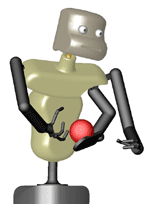 |
Project Overview
![]()
Short Term: Assessing the Robotic Mobility Platform
The Humanoid Robotics Group at MIT received a Segway Robotic Mobility Platform (RMP) in June, 2003. To date we have been conducting an assessment of the RMP with several questions in mind:
Q How useful is the RMP for humanoid robotics?
Q What research questions is the RMP ideal for investigating?
Q How does the RMP motivate particular, previously unconsidered robotics research questions?
We are deriving our assessment via a short term project that develops
a prototype mobile, humanoid robot with one arm. The goal of this robot,
named Cardea, is to navigate unstructured interior spaces using simple
active vision and sensors while being able to use its single arm to reach
out and interact with objects in compliant and safe ways. One behavior-level
scenario fitting these goals is Cardea wheeling along a corridor trying
to detect a door. Once the door is detected, Cardea will turn and approach
it, open the door, and enter the room. Note that the fluency and detailed
execution of such a scenario can be incrementally extended to include
very difficult mobile manipulation challenges such as handle turning,
force sensitive object interaction plus active vision challenges such
as generalized object detection. Watch
it in action.
Long Term: Mobile Manipulation

Mobility: Humanoid mobility has been hard to approach because bipedal walking is a big challenge onto itself. Equipping a humanoid robot with wheels has been discouraging because the wheel base to support a humanoid torso and body parts that extend to human-level height has to be prohibitively wide. The Segway RMP’s dynamic balancing on wheels provides us with the agility of a narrower wheel base in tandem with the facility of mounting torso, arms and robotic head at human-level height.
Manipulation: Conventional robot manipulators rarely operate in the real world. They are confined to environments such as factory floors where they perform repetitive sequences (albeit complex) in scripted, highly constrained situations. These manipulators are usually not safe to spontaneously interact with. Because they are stiff and position controlled, they are not sensitive to objects (or people!) that obstruct their planned path. When obstructed, they can do damage to themselves (by burning out their motors) or to people.
Series elastic actuators in robotic arms can alleviate these problems. A series elastic actuator has an embedded spring that allows the forces interacting with the manipulator’s axis to be sensed. Using this force information, a spring model can be used to control the manipulator. Spring models allow the compliancy and responsiveness of a human arm that has muscles, tendons and bone elements to be coarsely approximated. We plan to build 3 different arm-like manipulators for Cardea. The arms will likely have 6 degrees of freedom: 3 at the shoulder, 1at the elbow and 2 at the wrist. They will differ in terms of the lengths and proportions of their joint segments. At the end of each arm, there will be a different end effector, perhaps specially suited to different purposes.
Three arms will allow Cardea to explore a larger workspace that has hitherto not been considered. Cardea would have the potential to carry something while unscrewing or opening it. Plus, three arms provide three combinations of two arm pairs increasing the range of manipulation conditions Cardea will be able to handle. With three arms, Cardea can extend beyond the assumptions and conventions of the humanoid condition.
Active Perception: Our most recent research on the humanoid robot Cog has allowed us to make progress on active segmentation within the scope of active perception. In one approach, we turned the tables by using manipulation to aid vision, rather than using vision to aid manipulation. Nevertheless, Cog has a limited means of actively engaging the world. When Cog explores the world, we must bring the world to Cog. It actively explores its permanently fixed workspace but, this engagement must be facilitated by others who place objects (and themselves) within its workspace. With mobility, we envision that Cardea will actively seek objects (and people) beyond its current workspace and use its mobility to go over and explore them. This will further enhance the notion of active perception for a humanoid robot.
Social Interaction and Robot Tasking: We’ve also made progress with understanding the leverage and challenges of sociable robots with Kismet and Cog. Understanding the nature of the social relationship between a person and a humanoid robot provides insight into natural tasking of robots through demonstration and imitation. Cardea will be outfitted with a head that, at the least, will serve two functions: it will be an active vision platform with human like visual properties such as cameras that act and move as its eyes, and, its face will provide it with social character and social inter-operability.